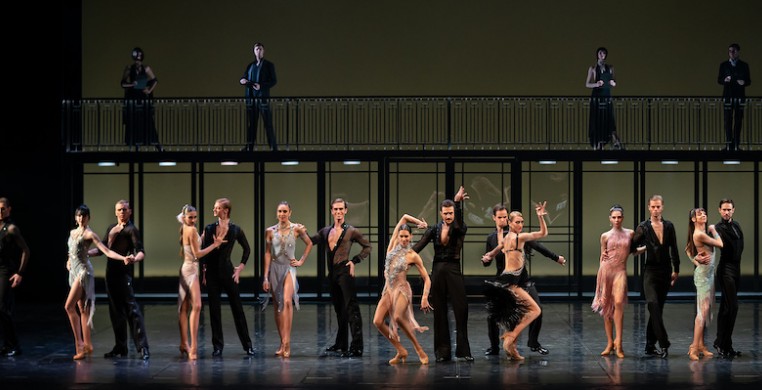Pygmalion meets Grotowski in Boris Eifman’s “The Pygmalion Effect,” receiving its North American premiere at Chicago’s Auditorium Theatre this weekend.
The Eifman Ballet of St.Petersburg, Russia, established in 1977, first graced the Auditorium stage in 2000, and has appeared there biannually since 2009.
In his latest work, Eifman borrows from the myth of Pygmalion to mine the psychological roots of transformation, combining rigorous physical theatre with classical ballet technique. The result is a dazzling spectacle that cracks open stereotypes of what ballet is all about while paying homage to its enduring traditions.
Polish theatre innovator Jerzy Grotowski’s bold experiments directing for the Polish Laboratory Theatre during the 1960s paved the way for a theatre of confrontation. His search for emotional truth pushed the boundaries of physical limitation in an effort to unleash our most primal impulses. A similarly fierce purpose drives Eifman’s unique creative engine, but its vehicle in “The Pygmalion Effect” is more like a circus clown car that spills out countless episodes of comedy, tragedy, vaudeville, slapstick, romance and intrigue, all to the tunes of Johann Strauss, Jr., and his brothers, Josef and Eduard, with a little Mozart thrown in for good measure.
The earliest record of the story of Pygmalion dates back to ancient Greek mythology, its best known version published in 8 AD as one of the myths in Ovid’s "Metamorphoses," which means “transformations.” In Ovid’s story, Pygmalion is a sculptor who carves a statue of a woman so beautiful, he falls in love with her and prays secretly to Aphrodite, the goddess of love, to bring her to life. His wish is granted, they marry and live happily ever after. In the myth, her name is Galatea. In 1871, W.S. Gilbert penned “Pygmalion and Galatea,” and a comedic inversion ensued, with Galatea preferring life as a statue. Eifman's take on the story veers in this direction as well, posing the question, can you really change the essential nature of another person?
Today, we are most familiar with George Bernard Shaw’s play, “Pygmalion” (1913), and Lerner and Loewe’s musical adaptation of that play, “My Fair Lady” (1964), whose variations on Ovid’s theme use the cultural norms of language and speech as the transformative agent. In Shaw’s play, Eliza Doolittle, a cockney street urchin who sells flowers and dreams of a better life, has a chance encounter with Henry Higgins, a phonetics professor, who makes a bet with his chum that he can pass her off as a duchess by changing her speech.
In Eifman’s extrapolation, the language of movement and the culture of ballroom dance competitions substitute for spoken language. Eifman plays on the name Galatea with two characters, Gala a ragamuffin street urchin, and Tea, the social-climbing dance partner to the fabulously wealthy dancing phenomenon, Leon. Reminiscent of Odette/Odile competing for Siegfried in the ballet “Swan Lake,” dramatic tension between the two women heightens the stakes for Gala, who falls in love with her master. Eifman makes ample use of the puppet/puppet master image (“Pinnochio” is yet another spin-off of the Greek myth) to suggest how one individual imposes his will upon another in the struggle for domination in relationship.
The ner-do-well drunken father character of Holmes, portrayed to fabulous extremes by Dmitry Fisher, parallels Shaw’s Doolittle. His solo on a park bench delivered a character portrait as nuanced as a Shaw monologue. Igor Subbotin as the Coach stands in for Colonel Pickering with prickly precision.
Unlike Shaw’s “Pygmalion,” Eifman employs a “deus ex machina” short-cut in the form of an electronic crown to force Gala’s body into submission. It would have been so much more fun to see “The Rain In Spain” moment evolve naturally out of Leon and Gala’s relationship, and perhaps more theatrically honest.
Eifman’s ballet brings theatrical complexity to his storytelling, both in the libretto and the marvelously original movement vocabulary that unlocks the inner workings of each of his characters, as well as his chameleon corps de ballet who change costumes and characters on a dime.
Lyubov Andreyeva as Gala endears herself to the audience with her gamine enthusiasm for life, a slightly naughty sense humor, and an elastic body that elongates like silly putty in a marvel of carefree gymnastics that defy human physiology. While she is the most fun as the earthy street urchin, her transformation, from ribald rawness to automaton to first-place ballroom dance lyricism and sophistication, gives us a chance to experience both her interpretive and technical gifts as a dancer.
Alina Petrovskaya as Tea brings razor-sharp attack and a killer instinct to every dévelopé, and Oleg Gabyshev as Leon proved that a quadruple pirouette can in fact be a believable demonstration of angst.
The superb corps de ballet switched back and forth from Gala’s stomping, clomping, toed-in street pals to the impeccably turned-out, social-climbing ballroom dance competitors with lightning speed and enthralling movement contrast.
Eifman’s unconventional use of the very familiar Strauss tunes was one of the more brilliant ingredients in this highly satisfying production. Both his characters and our emotional perception of the music transformed through his imaginative visualization of the music’s potential for dramatic narrative.
The sheer beauty of Olga Shaishmelashvili’s peasant and ballroom costumes and Zinovy Margoliin’s sleek frame sets kept the story moving, complementing the storytelling with visual interest and excitement. And while I am loathe to mention that the all-too-wonderful corps sequences sometimes went on a little too long, and were perhaps a bit repetitive, the dancing was so delicious, I didn’t really care.
--
Eifman Ballet of St. Petersburg performs "The Pygmalion Effect" through Sunday at the Auditorium Theatre, 50 E. Ida B. Wells Drive. Tickets are $34-$130, available by clicking the event page below.


